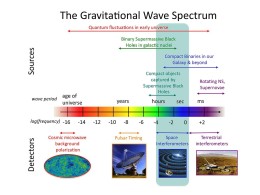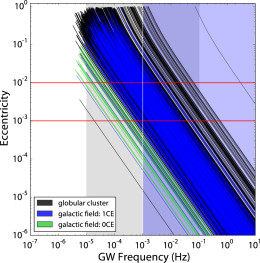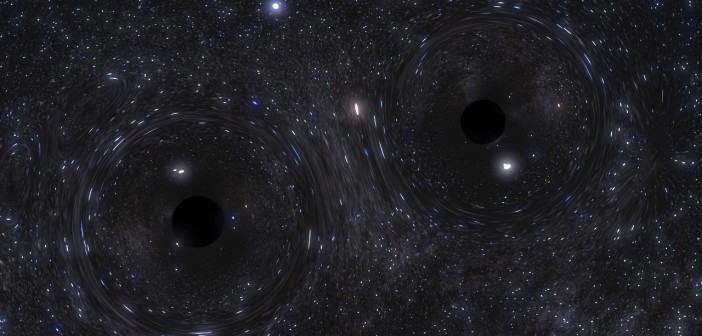
Artist’s impression of the European Space Agency’s Laser Interferometer Space Antenna, currently planned for a 2034 launch. [NASA]
Formation Channels
There are two primary places where stellar-mass black-hole binaries are thought to form:
- In isolation in the galactic field, as the components of a stellar binary independently evolve into black holes but remain bound to each other.
- In dense stellar environments like globular clusters, where the high density of already-formed black holes can cause a pair to dynamically interact and form a binary before being ejected from the cluster.
Can we differentiate between these origins based on future detections of gravitational waves from black-hole binaries? A team of scientists led by Katelyn Breivik (CIERA, Northwestern University) thinks that we can!

The gravitational-wave spectrum and how we detect it (click for a closer look!). While ground-based interferometers like LIGO detect black-hole binaries in the final moments before merger, LISA’s lower frequency band will allow it to detect binaries earlier in their inspiral. [NASA Goddard SFC]
Differentiation by Eccentricity
Breivik and collaborators believe that the key clue is the binary’s eccentricity. Gravitational-wave emission will eventually circularize all black-hole binaries during their inspiral. But in the first formation scenario, binary evolution processes like tidal circularization and mass transfer will reduce the binary’s eccentricity early on — whereas in the second scenario, the binaries that form in globular clusters may retain eccentricity in their orbits long enough that we can detect it.
Ground-based interferometers won’t be up to this task; by the time the binary orbits shrink enough to evolve into the LIGO frequency band, the orbits won’t have measurable eccentricity anymore. But the upcoming space-based LISA mission, which will operate in a lower frequency band, might be able to pick up this signature.
To determine if LISA can pull it off, Breivik and collaborators simulate two populations of binary black holes: one evolved in isolation in galactic fields, and the other formed dynamically in globular clusters and then ejected. The authors then explore the evolution of these populations’ masses and eccentricities as their orbits narrow into the LISA-detectable frequency band.

Eccentricity evolution tracks as a function of gravitational-wave frequency for black-hole binaries formed in dynamical scenarios (black) and in isolation (blue for those with a common-envelope episode, green for those without). Eccentricities above 10-2 are measurable for all binaries; those above 10-3 are measurable for 90%. LISA’s frequency band is shown in grey. [Breivik et al. 2016]
Separating Populations
Breivik and collaborators find that LISA will be able to make several important distinctions. First, if LISA detects binary black holes with eccentricities of e > 0.01 at frequencies above 10-2 Hz, we can be fairly certain that these originated from dynamical processes in dense stellar environments.
For binary black holes detected with eccentricities of e > 0.01 at lower frequencies, they could either have formed in dense stellar environments or they could have formed in isolation. Based on this study’s results, however, those with measurable eccentricities that formed in isolation most likely originated from a common-envelope formation. Measuring eccentricities of such systems in the future could provide constraints on the physics of how this formation mechanism works.
Though the field of gravitational-wave astronomy is only just beginning, its future is promising! Theoretical studies like this one will help us to extract a greater understanding from the observations we can expect down the road.
Bonus
Check out this beautiful simulation from Northwestern Visualization and Carl Rodriguez (a co-author on the above study) that shows what the formation of a binary black hole in a globular cluster might look like!
Citation
Katelyn Breivik et al 2016 ApJL 830 L18. doi:10.3847/2041-8205/830/1/L18


1 Comment
Pingback: Shaping Globular Clusters with Black Holes